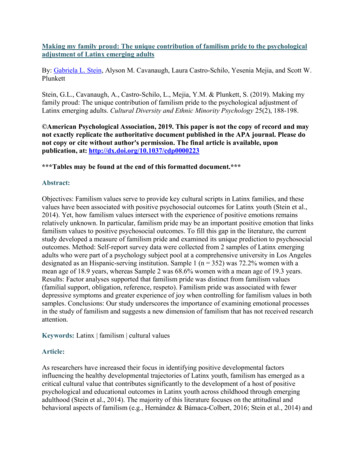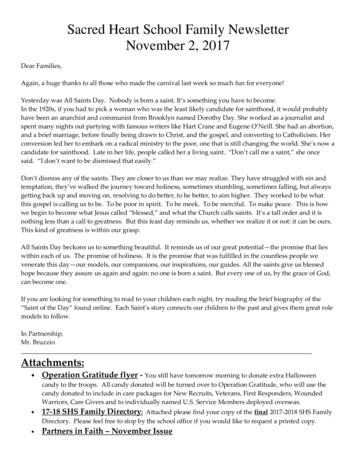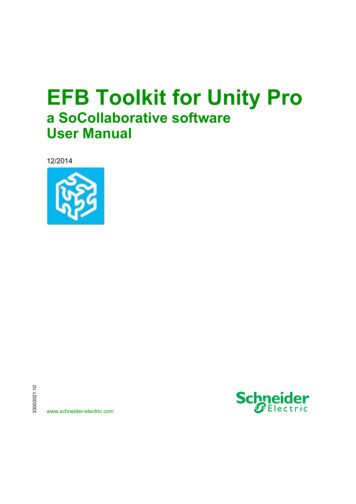
Transcription
Making my family proud: The unique contribution of familism pride to the psychologicaladjustment of Latinx emerging adultsBy: Gabriela L. Stein, Alyson M. Cavanaugh, Laura Castro-Schilo, Yesenia Mejia, and Scott W.PlunkettStein, G.L., Cavanaugh, A., Castro-Schilo, L., Mejia, Y.M. & Plunkett, S. (2019). Making myfamily proud: The unique contribution of familism pride to the psychological adjustment ofLatinx emerging adults. Cultural Diversity and Ethnic Minority Psychology 25(2), 188-198. American Psychological Association, 2019. This paper is not the copy of record and maynot exactly replicate the authoritative document published in the APA journal. Please donot copy or cite without author's permission. The final article is available, uponpublication, at: http://dx.doi.org/10.1037/cdp0000223***Tables may be found at the end of this formatted document.***Abstract:Objectives: Familism values serve to provide key cultural scripts in Latinx families, and thesevalues have been associated with positive psychosocial outcomes for Latinx youth (Stein et al.,2014). Yet, how familism values intersect with the experience of positive emotions remainsrelatively unknown. In particular, familism pride may be an important positive emotion that linksfamilism values to positive psychosocial outcomes. To fill this gap in the literature, the currentstudy developed a measure of familism pride and examined its unique prediction to psychosocialoutcomes. Method: Self-report survey data were collected from 2 samples of Latinx emergingadults who were part of a psychology subject pool at a comprehensive university in Los Angelesdesignated as an Hispanic-serving institution. Sample 1 (n 352) was 72.2% women with amean age of 18.9 years, whereas Sample 2 was 68.6% women with a mean age of 19.3 years.Results: Factor analyses supported that familism pride was distinct from familism values(familial support, obligation, reference, respeto). Familism pride was associated with fewerdepressive symptoms and greater experience of joy when controlling for familism values in bothsamples. Conclusions: Our study underscores the importance of examining emotional processesin the study of familism and suggests a new dimension of familism that has not received researchattention.Keywords: Latinx familism cultural valuesArticle:As researchers have increased their focus in identifying positive developmental factorsinfluencing the healthy developmental trajectories of Latinx youth, familism has emerged as acritical cultural value that contributes significantly to the development of a host of positivepsychological and educational outcomes in Latinx youth across childhood through emergingadulthood (Stein et al., 2014). The majority of this literature focuses on the attitudinal andbehavioral aspects of familism (e.g., Hernández & Bámaca-Colbert, 2016; Stein et al., 2014) and
has not fully explored whether the affective components of familism play a role in conferringpromotive effects. To fill this gap in the literature, the current study proposes a new measure offamilism pride to further the understanding of how positive emotions rooted in familism impactpsychosocial outcomes.FamilismFamilism is a multifaceted construct that encompasses both value endorsement (i.e., attitudinalfamilism) and the enactment of behaviors aligning with familism (i.e., behavioral familism; Steinet al., 2014). Familism values typically include obligations to the family, expectations of familialsupport, and family serving as a referent when making decisions (Knight et al., 2010), and somehave argued that respect for parents and familial elders are also part of the larger constructcritical to these values (i.e., respeto; Fuligni, Tseng, & Lam, 1999; Stein et al., 2014). Themajority of past work on familism has focused on the effects of familism values on adolescentpsychosocial outcomes, finding that familism values predicted fewer depressive symptoms,greater self-esteem, less substance use, less externalizing symptoms, greater academicmotivation, and more prosocial behavior (see Stein et al., 2014 for a review). These positiveeffects are, in large part, considered to be because of the enactment of familism values at boththe parental and child levels. In a theoretical review of the literature, Hernández and BámacaColbert (2016) identified key family behavioral processes that linked parental and youthendorsement of familism values to positive psychological adjustment in youth. Parental familismvalues led to positive parenting behaviors (e.g., warmth, support, monitoring), which directlypredicted youth self-esteem and less psychopathology. Similarly, youth familism valuespredicted prosocial behaviors and less engagement in risky behaviors, which led to the sameyouth outcomes. Although the larger mediational model has not been tested, the literaturesupported the links described previously.While these behavioral mechanisms are critically important, absent in this conceptualization isthe role of positive affect associated with familism values. Positive affect broadly defined hasbeen associated with the same psychological outcomes in adolescence (e.g., fewer depressivesymptoms, greater self-esteem; Davis & Suveg, 2014). In addition, familism values dictate theprovision of support to family members, including emotional support and beliefs about familialloyalty and connectedness (Lugo Steidel & Contreras, 2003). Conceptualizations of the familismreferent facet have included having pride (Gill, Wagner, & Vega, 2000) or feeling embarrassed(Sabogal, Marín, Otero-Sabogal, VanOss Marín, & Perez-Stable, 1987) by one’s family, furtherpointing to the role of emotions in this literature. Together, this suggests that the affectivecomponents of familism may need to be more strongly incorporated into its conceptualization.Past work has highlighted the need to distinguish between attitudinal and behavioral familism(Valenzuela & Dornbusch, 1994), and we argue that delineating value endorsement from theaffective components of familism would be useful to the field.Studies focusing on the behavioral enactment of familism values further point to an importantconnection between familism values and positive affect. In a daily diary study, Telzer andFuligni (2009) found that Latinx adolescents who provided more daily assistance to theirfamilies reported greater daily happiness, and this effect was mediated by greater satisfaction inbeing a good family member. In a follow-up neurocognitive experimental study, Mexican
American youth who endorsed greater familism values experienced greater activation in a rewardneural circuit when sacrificing rewards for themselves to give to their family (Telzer, Masten,Berkman, Lieberman, & Fuligni, 2010). This activation further predicted declines in subsequentrisk taking and depressive symptoms 1 year later (Telzer, Fuligni, Lieberman, & Galván,2013, 2014). Neurocognitive affect perspectives highlight that positive affect results fromresponse to reward, and therefore, can be understood as activation of the reward systems(Schultz, 2000). Taken together, acting in a way consistent with one’s familism values predictedfeelings of happiness that were evidenced by neurocognitive reward activation. These findingsunderscore the need to further understand how positive affect is experienced through the lens offamilism, as well as how this predicts psychological functioning.Positive Affect and PrideWe chose to focus on the role of pride as a central aspect of positive affect embedded in theexperience of familism. First, familism values include acting in accordance to familial referentsand not bringing shame to the family (Lugo Steidel & Contreras, 2003), suggesting that actingaccording to parental and familial mandates will bring honor and pride to the family, and feelingpride in one’s family has also been included in past measures of familism (Gill et al., 2000).Second, individual feelings of pride are considered to be a key positive emotional processinvolved in motivating social behavior (Tracy & Robins, 2007). Third, pride is the positiveemotion associated with achievement (Tracy & Robins, 2007), and we argue that pride would bethe emotion associated with the fulfillment of family obligations and expectations. Pride isconsidered to be different from other positive emotions because of its role in social functioning,providing information about one’s social status and reinforcing socially valued behaviors (Tracy& Robins, 2007). Given this social role of pride, for Latinx youth with high levels of familism,pride is likely a key emotion that motivates prosocial behavior and also accompanies thefulfillment of obligations and sacrifice associated with familism. Although not measured in theset of studies by Telzer and colleagues (2010, 2013, 2014) noted previously, we propose thatpride in acting in accordance to values of self-sacrifice serve as an important aspect of the“feeling good” (i.e., neural activation) when “doing good” (i.e., giving to family over self).While individuals endorsing familism values likely experience individualistically oriented pride(i.e., satisfaction in one’s self), positive affect is also experienced in bringing pride to one’sfamily or “making one’s family proud.” This goal of making one’s family proud becomes a keymotivator of positive behavior and achievement promoting adaptive behavior. Therefore, prideintersects with familism by eliciting pride when acting in accordance to one’s values, and also asa motivator to bring honor and pride to one’s family because of the happiness and satisfactionone feels in bringing happiness to other family members.In summary, the literature on familism has not fully examined the role of pride. Our study soughtto address this limitation in the literature by developing a new scale of familism pride that wouldhave the potential to increase our understanding of the mechanisms associated with thepromotive effects of familism. We believe this scale serves to bridge the literature focusing onthe behavioral mechanisms associated with familism and the neurocognitive studies byidentifying a key positive emotion that is socially embedded and motivates social behaviors.
Aims and HypothesesOur primary aim for the current study was the development of a familism pride scale and testingwhether it was an independent construct from other established familism value scales. Wehypothesized that the familism pride items would load on a factor that was sufficiently distinctfrom factors in the familism value scales but would be significantly correlated with familismsupport because of the emotional salience of the items.To further establish its contribution to the literature, we also examined whether familism prideuniquely predicted psychological outcomes previously associated with familism values in theliterature. We chose to examine depressive symptoms and self-esteem because there have beennumerous studies establishing the role of positive emotions with depressive symptoms (seereview by Davis & Suveg, 2014) and pride with self-esteem (Tracy & Robins, 2007), and bothoutcomes have been associated with familism values (Stein et al., 2014). In addition, we alsoexamined family responsive joy as a positive emotion embedded in familial experiences. Wehypothesized that familism pride would significantly predict these outcomes because they wereassociated with familism values in past literature (i.e., lower depressive symptoms, greater selfesteem, and greater responsive joy).We sought to establish convergent validity through the association between familism pride andother aspects of familism (i.e., familism support) and the psychosocial outcomes describedpreviously. In terms of discriminant validity, we also included ethnic pride (i.e., positive feelingsabout group membership; Rivas-Drake et al., 2014) to distinguish familism pride from otheraspects of pride in the literature of ethnic minority family functioning.MethodProceduresData for this study came from a larger study examining family qualities related to mental healthof emerging adults, which was approved by the university’s institutional review board.Participants were recruited from a psychology subject pool at a comprehensive university(designated as an Hispanic-serving institution) in Southern California. The subject pool wascomprised of students in a lower-division, general education, introductory psychology course.Students in the course are required to participate in research studies or complete an alternativeassignment.For Sample 1 (collected in Fall 2015), the participants completed a short paper-and-pencil surveyin a classroom setting (10–20 students in a group). Most participants completed the survey in 12–15 min. There were six “check questions” throughout the survey to determine whetherparticipants were reading the survey (e.g., “Please answer “agree” on this item to show you arereading the survey carefully”). Five Latinx participants were excluded from the data analysesbecause they missed more than one check question. Trained research assistants (RAs) collected,coded, and entered the data. Data coding and data entry were verified for accuracy in a multistepprocess.
In Spring 2018, the participants in Sample 2 completed an online survey in a computer lab (10–24 students in a group). Most participants completed the survey in 32–37 min. Eleven Latinxparticipants were excluded from the data analyses because they missed more than two checkquestions (out of 33 check questions).ParticipantsSample 1 was comprised of 352 participants (72.2% women, 27.3% men, 0.6% other) whoranged from 18 to 28 years of age (M 18.9 years) and self-reported in a Latinx group (e.g.,Latinx, Hispanic, Mexican, Chicano, Salvadoran). Most participants were freshmen (i.e., 58.5%),with 25.6% sophomores, 11.1% juniors, 4.0% seniors, and 0.9% missing. The family form of theparticipants follows: 73.0% two-parent, intact families; 6.0% stepfather families; 14.8% singlemother families; and the remaining came from other family forms. Most of the participants (i.e.,76.1%) lived at home. In regard to generation status, 13.6% were first generation (participant andparent born outside of the United States), 69.0% were second generation (participant was U.S.born, but both parents were foreign born), 8.0% were 2.5 generation (participant and one parentwere U.S.-born while one parent was foreign-born), and 9.4% third generation (participant andboth parents were U.S.-born). The birth places of the parents were Mexico (56.5% fathers, 53.5%mothers), El Salvador (15.6% fathers, 16.8% mothers), United States (10.5% fathers, 14.5%mothers), and Guatemala (9.2% fathers, 8.5% mothers). Most of the remaining parents were bornin Central or South America.Sample 2 was comprised of 315 Latinx participants (68.6% women, 31.4% men) who rangedfrom 18 to 27 years of age (M 19.3 years). Most participants were freshmen (i.e., 50.2%), with30.8% sophomores, 13.7% juniors, and 5.4% seniors. The family form of the participantsfollows: 71.7% two-parent, intact families; 6.0% stepfather families; 20.0% single-motherfamilies; and the remaining came from other family forms. Most participants (i.e., 79.4%) livedat home. In regard to generation status, 12.1% were first generation, 67.0% were secondgeneration, 12.4% were 2.5 generation, and 8.6% third generation. The birth places of mostparents were Mexico (59.4% fathers, 55.9% mothers), El Salvador (12.4% fathers, 14.3%mothers), United States (12.7% fathers, 16.8% mothers), and Guatemala (8.6% fathers, 7.6%mothers). The remaining parents were born in Central or South America.MeasuresFamilism pride. Two Mexican-origin (first generation) psychologists (one an expert of familismvalues) and one Mexican-origin psychology doctoral-level student (second generation)developed the familism pride measure. The measurement development process started with areview of past pride and familism measures (i.e., Knight et al., 2010; Lugo Steidel & Contreras,2003; Sabogal et al., 1987; Tracy & Robins, 2007) that were discussed. Positive affective wordsassociated with pride were identified in past measures (e.g., proud, happy, achieve, fulfilled), andkey familism items related to pride. Based on this review, we developed a nine-item scale (Table2) that assessed level of agreement on pride as motivator or feelings of pride emanating frommaking family proud or bringing happiness to family through success. We did not define thetypes of achievement or successes so that participants could define using their own metrics. Theresponse choices followed a 7-point Likert-type scale on level of agreement. Sample items
follow: “Making my family proud brings me happiness,” “My motivation for achieving things isto make my family proud,” and “I feel fulfilled when I achieve something that will make myfamily proud.” The scale demonstrated good internal consistency reliability (Sample 1 α .94;Sample 2 α .95).Familial cultural values. Participants completed a subset of the Mexican American CulturalValues Scale (MACVS; Knight et al., 2010) to assess four Mexican American familism relatedvalues: six-item family support, five-item family obligations, six-item referent familism, and sixitem family respect. The items were preceded with the following stem: “How much do youbelieve . . .” The items for each subscale are shown in Table 2. The response choices follow: 1 not at all, 2 a little, 3 somewhat, 4 very much, and 5 completely. This measure hasdemonstrated adequate reliability and has been validated in samples of Mexican American youthand their parents (Gonzales, Dumka, Mauricio, & Germán, 2007; Roosa et al., 2008). The scalesdemonstrated adequate to good reliability in our samples (Sample 1 αs .82–.88; Sample 2 αs .82–.90).Depressive symptoms. A 10-item version (Kohout, Berkman, Evans, & Cornoni-Huntley, 1993)of the longer 20-item Center for Epidemiological Studies Depression Scale (CES-D) was used toassess students’ depressive symptoms (Radloff, 1977) in Sample 1. Items are based on clinicaldiagnostic criteria for depression. The items are preceded by the following stem: “How oftenhave you been bothered by each of the following symptoms during the past 2 weeks?” Theresponse choices follow: 1 rarely or none of the time (less than 1 day), 2 some or a little ofthe time (1–2 days), 3 occasionally (3–4 days), and 4 most or almost all the time (5–7 days).Sample items include “I felt depressed” and “I could not get going.” In a sample of Latinxuniversity students, the 10-item scale was significantly and positively correlated with anotherwidely used depression measure (Alpizar, Plunkett, & Whaling, 2018). The scale demonstratedgood reliability (Sample 1 α .95).In the Sample 2, an eight-item version of the Patient Health Questionnaire (PHQ-9; Johnson,Harris, Spitzer, & Williams, 2002) was used to assess depressive symptoms (without thesuicidality item). The stem was, “How often have you been bothered by each of the followingsymptoms during the past two weeks?” A sample item follows: “Feeling down, depressed,irritable, or hopeless.” The response choices were 0 not at all, 1 several days, 2 more thanhalf the days, and 3 nearly every day. The scale demonstrated good reliability (Sample 2 α .90).Self-esteem. The 10-item Rosenberg Self-Esteem Scale was used to assess students’ self-esteem(Rosenberg, 1979). Sample items included, “On the whole, I am satisfied with myself” and “Ifeel that I have a number of good qualities.” Response choices follow: 1 strongly disagree, 2 disagree, 3 agree, and 4 strongly agree. Validity of the overall scale and subscales havebeen demonstrated with samples of Latinx adolescents (Supple & Plunkett, 2010). The scaledemonstrated good reliability (Sample 1 α .87; Sample 2 α .87).Family responsive joy. An eight-item scale was created for this study to assess familyresponsive joy. Sample items included, “I feel happy when I see my family laughing andenjoying themselves,” and “When someone in my family is feeling excited, I tend to get excited
too.” The response choices follow: 1 strongly disagree, 2 disagree, 3 somewhat disagree,4 somewhat agree, 5 agree, and 6 strongly agree. The scale demonstrated good reliability(Sample 1 α .95; Sample 2 α .91).Ethnic pride. Items from the 20-item Multi-Ethnic Identity Measure (Phinney, 1992) were usedto assess ethnic pride. Sample items included, “I am happy that I am a member of the group Ibelong to” and “I have a strong sense of belonging to my own ethnic group.” Response optionsfollow: 1 strongly disagree, 2 disagree, 3 agree, and 4 strongly agree. The five-itemscale demonstrated good reliability (Sample 1 α .85). This measure was not administered toSample 2.Data Analysis PlanUsing Mplus 7.3 (Muthén & Muthén, 1998–2012), we examined whether the subscales of theMACVS (familism support, obligation, referent familism, and respect) loaded on separateconstructs that were also distinct from familism pride, and whether the indicators were a strongrepresentation of the latent constructs. To accomplish this goal, we used the data from Sample 1to conduct an exploratory factor analysis (EFA) with Geomin rotation, with the full set of itemsbelonging to the aforementioned constructs. We selected Geomin rotation because we expectedcorrelated factors, its capacity to attain simple structure while minimizing variable complexity(Browne, 2001), and because it is preferred when there is no clear expectation about the trueloading structure (Asparouhov & Muthén, 2009). We relied on a combination of guidelines fordeciding on the appropriate number of factors to retain. First, we examined the scree plot of theeigenvalues of the variables’ correlation matrix, whose elbow at the fifth eigenvalue suggested afive-factor solution. Then, we compared fit indices (and not χ2because of our large sample size)across six models for which we extracted a range of one to six factors. We focused on thecomparative fit index (CFI), standardized root mean residual (SRMR), and root mean squareerror of approximation (RMSEA). Ideally, the CFI should be close to .95, and the SRMR andRMSEA should be .08 or lower for a model to have acceptable fit (Browne & Cudeck, 1993; Hu& Bentler, 1999). Notably, we used these values as guidelines and not as golden rules because ofthe risk of overgeneralizing such “rules of thumb” (Marsh, Hau, & Wen, 2004).Once we had the EFA solution, we moved to the structural equation modeling framework toexamine associations between the various familism domains and key outcome measures (i.e.,depressive symptoms, ethnic pride, self-esteem, and joy). Because the EFA solution allows forall items to load on all factors, we used the following criteria to select which indicators wouldload on which factors in a path model. Variables with standardized loadings of .3872 or higherwere specified as indicators of their corresponding factor. This assured that factors explaining atleast 15% of an item’s variance would retain the item as an indicator. Moreover, items that hadstandardized cross loadings of .3162 or higher (i.e., the factor explained at least 10% of thevariance) were specified to cross load onto the corresponding factor in the path model.Items that did not meet either of these criteria were dropped (i.e., items whose loadings were notsubstantial on any factor). Finally, rather than assuming that all our outcome variables had goodconstruct validity in our sample, we submitted them to additional EFAs. That is, each construct’sitems were separately used in an EFA to make sure they were valid indicators of the underlying
construct. As before, if items did not share at least 15% of the variance with the factor, they weredropped from further analyses.Because we had 54 variables (26 indicators of predictors and 24 as indicators of key outcomes),it was critical to use parcels to avoid an overparameterized model. Specifically,overparameterized models are likely to result in unstable solutions in addition to often havingpoor fit (Little, Cunningham, Shahar, & Widaman, 2002). Using the process describedby Kishton and Widaman (1994), we specified a one-factor EFA model of each measure. Then,we inspected the factor loadings to evenly distribute the true score variance across each of thethree parcels specified per latent variable. For example, the highest factor loading was placed onParcel 1, second highest on Parcel 2, third highest on Parcel 3, fourth highest on Parcel 3, fifthhighest on Parcel 2, sixth highest on Parcel 1, and so on. Given a minimum of three parcels withtwo items per parcel were needed, we did not create parcels for variables with five or less itemsbut instead used all five items as indicators of the latent variable.To test whether familism pride operated similarly in an independent sample (i.e., Sample 2), weconducted a path analysis with familism support, obligation, referent familism, respect, andfamilism pride predicting depressive symptoms, self-esteem, and joy. All measures weremanifest, summary variables and analyses were again conducted in Mplus v7.3 (Muthén &Muthén, 1998–2012).ResultsPreliminary Results: EFAsFit indices for the 6 EFAs are reported in Table 1. The six-factor solution had the best fit indices(CFI .91, SRMR .03, RMSEA .08). However, the standardized factor loadings for the sixthfactor ranged from .31 to .37, suggesting this factor was weakly defined. The fit of the fivefactor model was somewhat lower (CFI .88, SRMR .04, RMSEA .08), but all factors werewell defined. Thus, because the five-factor model showed better structure than did the six-factormodel, and the scree plot also pointed to a five-factor solution, we decided to retain this model.Using the five-factor model solution (see Table 2 for factor loadings), we dropped a total of sixitems (obligation1, obligation4, obligation5, respect2, respect4, respect8, respect1) because theirrespective factor did not explain at least 15% of their variance. Dropping these items resulted inimproved model fit according to the CFI .91 and SRMR .03, but not the RMSEA .09(although the latter’s 90% confidence interval included .08). Table 3 shows the factor loadings ofthe five-factor solution after trimming the model. The factors that emerged in the solution werefamilism support, familism obligation, familism referent, familism respect, and familism pride.Each of these factors were distinct but correlated, with interfactor correlations ranging between.27 and .66 (Table 3).Next, we conducted EFA models of all outcome variables. This enabled us to empirically assessthe dimensionality of the constructs under investigation rather than assuming unidimensionality.Using the CESD shortened measure of depressive symptoms, four items out of 10 were droppedbecause they loaded on a separate factor, were nonsignificant, or the factor did not explain at
least 15% of their variance. The items that were dropped were as follows: (a) “I felt thateverything I did took a lot of effort,” (b) My sleep was restless,” (c) “I was happy” (reversecoded), and (d) “I enjoyed life” (reverse coded). For the same reasons, we dropped the fivenegatively worded items of the 10-item Rosenberg self-esteem scale, which is in line withprevious research on Latinx adolescents demonstrating the negatively worded items may reflect adistinct construct of self-deprecation (Supple & Plunkett, 2010).Primary Results: Structural Equation Model in Sample 1With all psychometric analyses completed, we proceeded to fit the structural equation model offamilism values predicting key outcomes. Results indicated that familism pride significantlypredicted lower levels of Latinx students’ depressive symptoms (b 0.15, SE 0.05, p .004)above and beyond familism support, obligation, referent familism, and respect (Figure 1). Noneof the predictors significantly predicted Latinx students’ ethnic pride. Familism support (b 0.21, SE 0.09, p .025) and familism pride (b 0.12, SE 0.05, p .009) significantlypredicted higher levels of Latinx students’ positive self-esteem. Similarly, familism support (b 0.32, SE 0.13, p .009) and familism pride (b 0.20, SE 0.06, p .002) significantlypredicted higher levels of Latinx students’ family responsive joy.Figure 1. The structural model including familism pride: χ2(459) 798.67, p .00; comparativefit index (CFI) .95; root mean square error of approximation (RMSEA) .05; RMSEA 90% .04–.05; standardized root mean residual (SRMR) .04. Pfsup parcels, family support; Famobl family obligation; Famref familism referent; Famresp family respect; Pfpride familismpride. Unstandardized coefficients are displayed in parentheses. Dashed lines indicatenonsignificant paths. * p .05. ** p .01.Path Analysis in Sample 2
We investigated whether effects from Sample 1 were replicable in an independent sample. Asdisplayed in Figure 2, familism pride significantly predicted lower levels of depressivesymptoms (b 0.16, SE 0.04, p .001) and higher levels of self-esteem (b 0.18, SE 0.03 p .001) and joy (b 0.31, SE 0.04 p .001). In addition, obligation also predictedhigher levels of depressive symptoms (b 0.15, SE 0.07, p .039) and joy (b 0.31, SE 0.07 p .001). Fitting this model with all predictors as latent variables led to the exact samepatterns of significance.Figure 2. The path model for Sample 2 including familism pride: χ2(0) 0, p .000;comparative fit index (CFI) .95; root mean square error of approximation (RMSEA) .00;RMSEA 90% .00–.00; standardized root mean residual (SRMR) .00. Unstandardizedcoefficients are displayed in parentheses. Dashed lines indicate nonsignificant paths. ** p .01.Post Hoc Analyses in Sample 1As a follow-up test, we explored whether familism support, obligation, referent fami
according to parental and familial mandates will bring honor and pride to the family, and feeling pride in one's family has also been included in past measures of familism (Gill et al., 2000). Second, individual feelings of pride are considered to be a key positive emotional process involved in motivating social behavior (Tracy & Robins, 2007).










